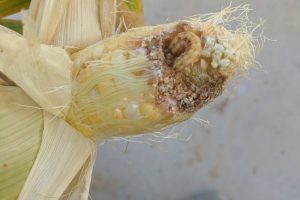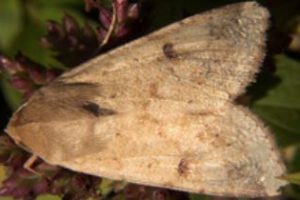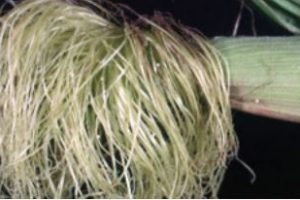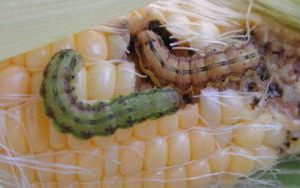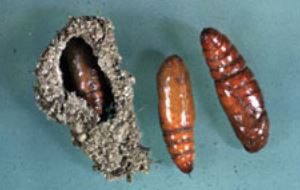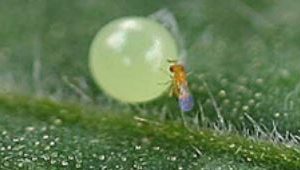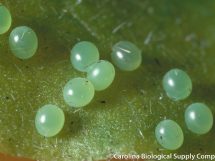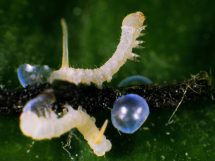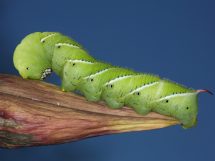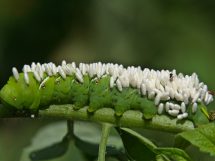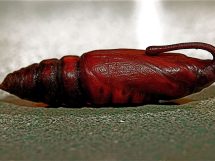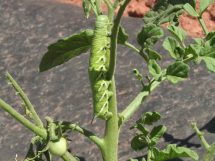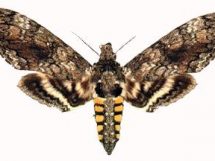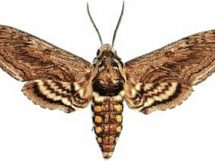Tomato Fruit Worm / Corn Earworm
Description:
Corn Earworm (CEW) and Tomato Fruit worm are common names given to the larvae stage of Helicoverpa zea. CEW is the most destructive pest to Utah’s sweet corn. The larvae have a brown head with alternating dark and light stipes along the length of its body. The adult moth is tan with a distinct spot and dark margin on its forewings. CEW overwinters in the pupae stage in central and southern Utah; and immigrates into northern Utah each spring.
Damage:
CEW can cause several types of injury. Direct damage usually occurs at the ear tip by feeding on kernels, also damage to the silk can decrease pollination leading to poor ear development. In tomatoes, CEW larvae will tunnel into the fruits and chew holes in the leaves, stems, and flowers
Monitoring:
Adult moths are most active at dusk, and can be carried by wind currents traveling hundreds of miles. CEW moths lay individual eggs on fresh, green corn silks. A female moth can lay up to 1,000 eggs. In northern Utah, three flights typically occur a year. Around now in late August and September would be the estimated time for the second and third flights. CEW is best monitored using a pheromone lure in a net trap. Traps are cone shaped and made of vinyl mesh netting.
Management:
Cultural Control
- Plant sweet corn earlier in the season to allow for the silk to develop before moth activity occurs.
- Tilling corn fields in the fall will decrease the survival rate of pupae.
Biological Control
- Trichogramma wasps are parasitic toward CEW eggs. Wasps can be purchased and released into corn fields.
Chemical Control
Options available for commercial growers:
- Bacillus thuringiensis (Dipel, Thuricide, others)
(not effective on moths, must be ingested by larvae; effective in tomato and pepper if reapplied every 2 to 3 days; not effective in corn) - bifenthrin (Brigade)R
- cyfluthrin (Baythroid)R
- esfenvalerate (Asana)R
- horticultural mineral oil (many brands)
(suffocate eggs on silks, must reapply every 2 to 3 days for suppression only) - lambda-cyhalothrin (Warrior)
- malathion (Malathion)
- methomyl (Lannate)
- permethrin (Ambush, Pounce)
- spinosad (Spintor, Success, EntrustO)
(effective upon ingestion by larvae, but no contact activity; effective for tomato and pepper, but not corn) - thiodicarb (Larvin)
- zeta-cypermethrin (Mustang)
Options available for home growers:
- bifenthrin + zeta-cypermethrin (Ortho Bug-B-Gon Max Lawn and Garden Insect Killer)
- cyfluthrin (BioAdvanced Vegeetable and Garden Insect Spray)
- lambda-cyhalothrin (Spectracide Triazicide)
- pyrethrins + piperonyl butoxide (Worry-free Insecticide and Miticide)
- zeta-cypermethrin (GardenTech Sevin)
- Bacillus thuringiensis (many brands)
More Information:
- Corn Earworm Fact Sheet (USU Extension Fact Sheet)
- Corn Earworm (Utah Vegetable Production & Pest Management Guide)
- Tomato Fruitworm (USU Extension)
Tomato & Tobacco Hornworm
Description:
Tomato and tobacco hornworms are closely related species that cause similar damage to the same host plants. Both are equivalent in size and appearance. Tomato hornworms are the larval stage of the five spotted hawkmoth (Manduca quinquemaculata) and tobacco hornworms are the larval stage of the Carolina sphinx moth (Manduca sexta). Tomato and tobacco hornworms can both be found throughout Utah attacking host plants. Larvae of both species have five pairs of prolegs (fleshy abdominal limbs of a caterpillar), are a cylindrical shape, and are 4 inches long at maturity. The tomato hornworm is green with eight, white “V” markings along its back, pointing toward the head. At the end of its abdomen is a notable black tail spine.
Damage:
Hornworm larvae have chewing mouthparts, and primarily feed on the host plant’s foliage. In their final instar and high populations, they can cause significant economic damage to crops. Hornworms will begin consuming the upper leaves first, and slowly move downward to lower leaves (Fig. 7). Loss of foliage may decrease fruit production and increase the risk of sunscalded fruit. Larvae also feed on fruits, blossoms, and stems when foliage runs out or populations are high.
Management:
Mechanical Control
- Physically remove and destroy hornworms when found on plants.
- Till the soil in the spring or fall to disrupt overwintering pupae stage.
Biological Control
- Braconid wasps (Braconidae) are another important natural enemy, specifically Cotesia congregatus that parasitizes hornworms. This parasitoid lays its eggs inside hornworms. The eggs hatch and the wasp larvae then feed on the inside of the caterpillar.
Chemical Control
Options available for commercial growers:
- Bacillus thuringiensis (XenTari)
- carbaryl (Sevin, Carbaryl)
- spinosad (Entrust, Success)
- fenpropathrin (Danistol)
- emamectin-benzoate (Proclaim)
Options available for home growers:
- zeta-cypermethrin (Garden Tech Sevin)
- spinosad (Bonide Captain Jack’s Deadbug, Monterey Garden Insect Spray, Natural Guard Spinosad Spray)
- Baciluius thuringiensis (many brands)

